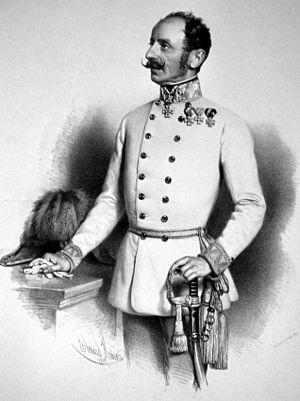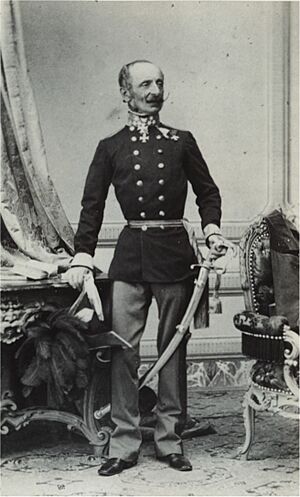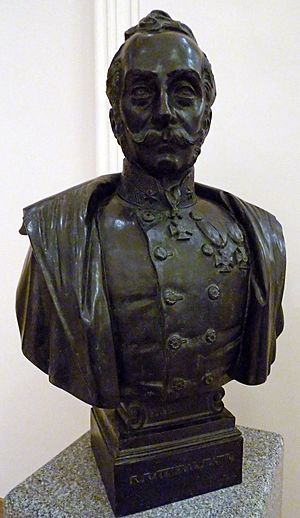Ludwig von Benedek facts for kids
Quick facts for kids
Ludwig von Benedek
|
|
|---|---|

Ludwig von Benedek (lithography of Eduard Kaiser, 1857)
|
|
| Born | 14 July 1804 Sopron, Kingdom of Hungary |
| Died | 27 April 1881 (aged 76) Graz, Austria-Hungary |
| Allegiance | |
| Years of service | 1822–1866 |
| Rank | Feldzeugmeister |
| Battles/wars | Kraków Uprising Hungarian Revolution of 1848 First Italian War of Independence Second Italian War of Independence Austro-Prussian War |
| Awards | Military Order of Maria Theresa |
Ludwig August Ritter von Benedek (July 14, 1804 – April 27, 1881), also known as Lajos Benedek, was an important general from Austria-Hungary. He is most remembered for leading the Austrian army in a big battle in 1866. This battle, called the Battle of Königgrätz, was against the Prussian Army. The Austrians lost, and this battle marked the end of Benedek's military career.
Contents
Early Life of Ludwig Benedek
His Younger Years
Benedek was born in Sopron, a city in Hungary. His father was a doctor. Ludwig went to the Theresiana Military Academy in Wiener Neustadt for his training. He did very well, graduating seventh in his class.
In 1822, he joined the 27th infantry regiment of the Austrian Imperial Army. He became a first lieutenant in 1833. By 1835, he was promoted to the rank of captain.
In 1840, Benedek became a major. He worked as an assistant to the General Commander in Galicia. He was promoted again to lieutenant-colonel in 1843. In 1846, he helped stop an uprising in the town of Gdow. For this, he received the Knight's Cross of the Order of Leopold and became a colonel.
Commander in Italy
In August 1847, Benedek was given command of the 33rd infantry regiment in Italy. On April 5, 1848, he took charge of a new military group called a brigade. This brigade fought in the First Italian War of Independence many times. A notable battle was at Curtatone in 1848. The next day, Benedek led his troops in the Battle of Goito.
After these battles, Benedek received more awards. These included the Commanders' Cross of the Order of Leopold and the Knight's Cross of the Military Order of Maria Theresa. These awards officially made Benedek a knight. On April 3, 1849, he became a major general. He was then appointed to work with the Chief of Quartermaster-General for the 2nd Army in Italy.
Military Service in Hungary and Italy
Hungarian Revolution
In 1849, Benedek was sent to Hungary. He led troops in the Battle of Győr. He played a key role in stopping the rebellion. He was seriously wounded in another battle at Szőreg. He received the Military Merit Cross and was made a regimental colonel. Benedek then became the chief of staff for Radetzky in Italy.
He was promoted to Feldmarschallleutnant in 1852. When Radetzky retired in 1857, Benedek became the commander of the II Army Corps.
Battle of San Martino and Solferino
In early 1859, Benedek was the commander general of the VIIIth army corps in the Second Italian War of Independence. On May 27, 1859, he was promoted to the rank of Feldzeugmeister. This made him second in command of the entire Austrian Army. On June 24, he fought in the Battle of Solferino. This battle was against the French troops led by Emperor Napoleon III. The young Emperor Franz Joseph I commanded the Austrian forces.
Benedek's troops were attacked on their right side by the army of King Victor Emmanuel II of Piedmont-Sardinia. This happened a few kilometers north of Solferino in the Battle of San Martino. The Austrian units pushed the Piedmontese back at first and held their ground. Meanwhile, Emperor Franz Joseph was defeated at Solferino. Benedek then helped his army retreat safely to San Martino. Benedek received the Commander's Cross of the Military Order of Maria Theresa in 1859.
After the Austrian defeat, Benedek was given new important roles. On January 31, 1860, he became Chief of the General Quartermaster Staff. In April, he became the governor of Hungary.
On October 20, 1860, Benedek took command of Austrian forces in several regions. These included Lombardy-Venetia, Carinthia, Carniola, Tyrol, and the Adriatic Coastland. He received the Grand Cross of the Order of Leopold with War Decoration on January 14, 1862.
Benedek's Military Beliefs
Benedek strongly believed that the army was the main protector of the Habsburg monarchy. He thought it needed to protect the monarchy from new ideas like liberalism and nationalism. He believed that loyalty to the royal family and the emperor was most important. He was also suspicious of civilian professionals and business people.
In a message to his officers in March 1861, he warned against "international revolutionaries." He also mentioned "lawyers and doctors without practices, ambitious and money-hungry journalists, dissatisfied professors and schoolteachers." He added "debt-ridden nobles and cowardly magnates" as threats to the monarchy. A year later, he said in Verona that the army's purpose was "to serve, fight, and if necessary die with honor for the emperor and supreme warlord."
Benedek believed in a traditional way of fighting wars. He thought bravery and courage were most important. He felt that "simple rules" were better than "complicated calculations." Because of this, he did not like the idea of a national general staff. This was a Prussian-style group of officers chosen for their education and intelligence.
Austro-Prussian War
The Battle of Königgrätz
When the Austro-Prussian War started in 1866, Benedek was made the commander-in-chief of the Northern Army. He had refused this job three times before. He said he did not know the land in the north or the enemy well. He delayed leaving Verona for almost two months. He only arrived in Vienna on May 12. He did not set up his main office in Olmütz (Olomouc) until May 26. Also, his two chiefs of staff, von Krismanić and von Henikstein, made him feel even more doubtful about fighting.
The Prussians moved forward and defeated Austria's German allies. These included Hanover, Hesse-Kassel, and Saxony. But Benedek stayed in a defensive position. Emperor Franz Joseph's helper, Lieutenant Colonel Friedrich Beck, urged Benedek to attack. However, Benedek and his staff replied that the army was not ready.
Benedek focused on military uniforms and ceremonies. He stressed the importance of close combat, even though the Prussians had better needle guns. He only moved his troops at the end of June. They marched in three groups and took defensive spots near the fortress of Josefstadt. They also guarded the Saxon and Silesian mountain passes.
When the Prussians entered Bohemia, Benedek failed to bring his forces together. His army suffered defeats in many places. One costly stand was at Trautenau. He then changed his tactics and finally saw the importance of artillery fire before bayonet charges. But the spirit of both leaders and soldiers was low. Benedek ordered his troops back to Olmütz. He said a "catastrophe" was coming. He begged the emperor to make peace with Prussia. When the emperor refused, Benedek set up his army in a defensive position. This was along the Elbe river between Sadowa and Königgrätz.
On July 3, 1866, the Prussians attacked. Benedek had more soldiers. But he only expected to face the Prussian First Army. The arrival of the Prussian Second Army, led by Crown Prince Frederick William, changed everything. They attacked the Austrian side at Chlum, breaking the Austrian lines. Benedek ordered a retreat. He crossed the river himself that evening. He told the emperor that the disaster he feared had indeed happened. He offered to gather the army again at Olmütz. But the retreat turned into a near complete defeat. On July 10, Archduke Albrecht was made commander of all armies. He set up defenses around Vienna. However, the Prussians had achieved their goals. They were also suffering from a cholera outbreak. The Austrians desperately wanted the fighting to end. An agreement for a ceasefire was signed on July 21.
Loss of Command
This situation put Emperor Franz Joseph I in a difficult spot. Many people demanded that Benedek be blamed for the defeat. He resigned as commander-in-chief at Pozsony (Bratislava) on July 26, 1866. The highest military court wanted to hold a court martial against him. They planned to investigate the battle. However, the emperor stopped this investigation.
Benedek was ordered never to speak about the defeat. On December 8, 1866, a harsh article in the Wiener Zeitung blamed him alone for the disaster. He was not allowed to respond.
The former top soldier of the Empire lived quietly in retirement at Graz for another fifteen years. He passed away there on April 27, 1881.
Images for kids
See also
 In Spanish: Ludwig von Benedek para niños
In Spanish: Ludwig von Benedek para niños






